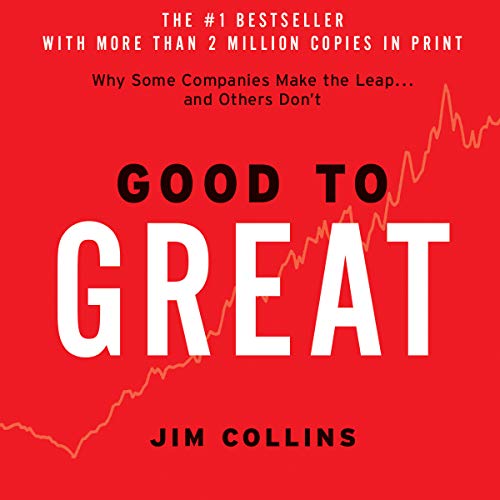Good to Great
Why Some Companies Make the Leap… and Others Don't
by James C. Collins
“Collins has given business leaders a wonderful gift in Good to Great... a masterpiece of analytical thinking.”
“Jim Collins’ carefully researched and well-written book, Good to Great, is a must-read for any executive or business leader who wants to understand how to create a superior company.”
Good to Great is a non-fiction book by Jim Collins that explores what sets great companies apart from good ones. Collins and his team of researchers analyzed data from a range of companies over a five-year period and identified common characteristics that set the best performing companies apart. The book has become a classic in the business genre and is a must-read for anyone interested in understanding the principles of great leadership and how to build a successful organization.
The book begins by outlining the criteria for selecting the companies that were studied. Collins and his team looked at companies that had a history of good performance, but had then made the leap to great performance and sustained that performance over a long period of time. They identified eleven companies that met these criteria, which they refer to as "good to great" companies. These companies included household names like Walgreens, Circuit City, and Wells Fargo.
The book is divided into several chapters, each focusing on a different aspect of what sets these companies apart. Here are some of the key takeaways:
Level 5 Leadership
The most important factor that sets great companies apart from good ones is the presence of what Collins calls "Level 5" leadership. This type of leadership is characterized by a paradoxical blend of personal humility and professional will. Level 5 leaders are incredibly ambitious for their companies, but they are also humble and not concerned with personal ego or glory. They are focused on the success of the company and the people who work for it, rather than their own success or recognition.
The Hedgehog Concept
Another important factor that sets great companies apart is their ability to focus on what Collins calls the "Hedgehog Concept." This concept is based on the ancient Greek parable of the hedgehog and the fox. The fox is a cunning animal that knows many things, but the hedgehog only knows one thing: how to defend itself. In the same way, great companies are able to identify the one thing that they are best at and focus all of their energy and resources on that one thing. This allows them to be highly successful in their chosen area, rather than being mediocre at many things.
The Flywheel Effect
Collins also identifies the importance of what he calls the "Flywheel Effect." This concept is based on the idea that great companies achieve success through a series of small, incremental steps, rather than through one big, dramatic leap. The Flywheel Effect is similar to the idea of a flywheel in mechanics: it takes a lot of effort to get the flywheel turning at first, but once it gets going, it builds momentum and becomes easier and easier to turn. Great companies build momentum in the same way, through a series of small, consistent actions that build on each other over time.
Culture of Discipline
Finally, Collins emphasizes the importance of creating a culture of discipline within great companies. This involves setting clear goals and expectations, and holding people accountable for meeting those goals. It also involves a willingness to make difficult decisions and to stay true to the company's core values, even in the face of adversity or temptation. Collins argues that great companies are able to achieve this kind of discipline because they have a strong sense of purpose and a deep commitment to their values.
In addition to these key takeaways, Good to Great also includes a number of other insights and recommendations for building a great company. These include:
Getting the right people on the bus: Collins argues that great companies are able to achieve success because they have the right people in the right positions. This involves not only hiring the best talent, but also ensuring that everyone is aligned with the company's core values and goals.
Embracing technology as an accelerator, not a creator: Collins argues that great companies use technology to accelerate their success, but they do not rely on technology to create it. In other words, technology is a tool that great companies use to amplify their strengths and advantages, but it is not the source of those strengths and advantages.
Conducting rigorous analysis and self-reflection: Collins emphasizes the importance of constantly analyzing and reflecting on the company's performance, in order to identify areas for improvement and to stay ahead of the competition. This involves a willingness to ask difficult questions and to challenge assumptions, even when it is uncomfortable or inconvenient.
Balancing continuity and change: Finally, Collins argues that great companies are able to balance continuity and change, by maintaining a clear sense of their core values and purpose, while also being willing to adapt and evolve in response to changing circumstances. This requires a willingness to take calculated risks and to be open to new ideas, while also staying true to the company's identity and mission.
Overall, Good to Great is a highly informative and inspiring book that offers valuable insights into what it takes to build a truly great company. Its focus on the importance of strong leadership, clear values, and disciplined action make it a must-read for anyone interested in achieving long-term success in business or any other field.
Business Floss is reader-supported. When you use our links we may earn an affiliate commission that helps us keep the site running. Thank you for your support!

